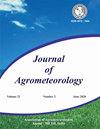利用印度旁遮普邦的气象数据建立柑橘白粉病(Diaphorina citri Kuwayama)在金诺柑橘上的种群预测模型
Q3 Agricultural and Biological Sciences
引用次数: 0
摘要
通过田间试验,研究了柑橘白粉虱(Diaphorina citri Kuwayama)在金诺柑橘上十二年(2007-08 年至 2019-20 年)的种群动态与不同天气参数的关系,并建立了种群预测模型。全年都能观察到成虫,但 11 月至 1 月期间种群数量很少。在三月和九月观察到两个种群高峰。在 9 月的第二个双周,平均虫量最高(80.8 头/25 根树枝),不同年份的情况也不尽相同。虫量与最高和最低温度、蒸汽压、风速、日照时数和降雨量呈显著正相关,而与相对湿度和雨日数呈负相关。建立了一个基于天气的模型,可提前七天预测白粉虱的数量。利用均方根误差、判定系数、Nash-Sctuliffe 效率和平均偏差误差等各种指标对模型进行了验证,结果表明,该模型对柑橘白粉虱数量的预测相当令人满意。因此,所开发的模型可提前七天用于旁遮普省柑橘白粉病的天气预测,效果令人满意。本文章由计算机程序翻译,如有差异,请以英文原文为准。
Population prediction model of citrus psylla, Diaphorina citri Kuwayama on Kinnow Mandarin using weather data in Punjab, India
Field experiments were carried out to study the population dynamics of citrus psylla, Diaphorina citri Kuwayama on Kinnow Mandarin for twelve years (2007-08 to 2019-20) in relation to different weather parameters and to develop population prediction model. Adult psyllids were observed throughout the year but the population was very low during November-January. Two population peaks were observed during March and September. Highest mean population (80.8 nymphs/25 twigs) was observed during second fortnight of September which varied in different years. Psyllid population showed significant and positive correlation with maximum and minimum temperature, vapour pressure, wind speed, sunshine hours, rainfall and negative correlation with relative humidity and number of rainy days. A weather-based model was developed to predict psylla population seven days in advance. The validation of the model carried out using various indices viz, root mean square error, coefficient of determination, Nash-Sctuliffe efficiency and mean bias error suggested that, the model predicted the population of citrus psylla quite satisfactorily. Thus, the developed model can be used satisfactorily for weather-based prediction of citrus psylla in Punjab, seven days in advance.
求助全文
通过发布文献求助,成功后即可免费获取论文全文。
去求助
来源期刊

Journal of Agrometeorology
农林科学-农艺学
CiteScore
1.40
自引率
0.00%
发文量
95
审稿时长
>12 weeks
期刊介绍:
The Journal of Agrometeorology (ISSN 0972-1665) , is a quarterly publication of Association of Agrometeorologists appearing in March, June, September and December. Since its beginning in 1999 till 2016, it was a half yearly publication appearing in June and December. In addition to regular issues, Association also brings out the special issues of the journal covering selected papers presented in seminar symposia organized by the Association.
 求助内容:
求助内容: 应助结果提醒方式:
应助结果提醒方式:


